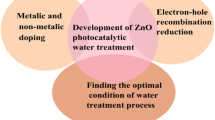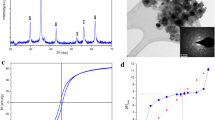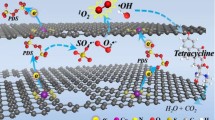Abstract
Heavy metals discharged into water by industrial activity give rise to severe environmental pollution. Herein, graphene oxide (GO) was prepared based on an improved Hummers method and utilized as adsorbent to remove aqueous Cu(II). The “species resolved” adsorption mechanism was deeply inspected via combining multiple explorations extracted from Cu(II) species distribution, GO surface charge, adsorption experiment and fitting, hard-soft acid-base (HSAB) theory, FTIR and XPS spectra. Different adsorption mechanism resolved by Cu(II) species was proposed, corresponding to different pH range. (1) When pH<8, bare Cu2+ is the dominant Cu(II) species, ion exchange and chemical complexation are the adsorption mechanism. (2) When pH=8, Cu(OH)2 is the dominant Cu(II) species, precipitation, ion exchange and chemical complexation are the adsorption mechanism. (3) When pH>8, Cu(OH) −3 is the dominant Cu(II) species, electrostatic attraction is the adsorption mechanism. Electron transfer and energy lowering calculated based on the HSAB theory demonstrates, OH is stronger than COOH regarding binding affinity towards Cu(II). As for adsorption efficiency, adsorption of Cu(II) onto GO equilibrated in 12 min, with adsorption percent and quantity 92.32% and 553.90 mg·g−1, respectively. Findings of this work may shed light on the interaction mechanism of graphene oxide with heavy metals. Accordingly, these as clarified mechanisms may provide guidance for developing efficient adsorbent based on graphene for heavy metal scavenging.
Similar content being viewed by others
Abbreviations
- i:
-
i=0, e, t, signifies the start, equilibrium and any moment t of adsorption, respectively, as in Eqs. (2)–(3).
- Ci :
-
concentration of Cu(II) solution [mg·L−1]
- D:
-
adsorbent dosage [mg·L−1]
- Ri :
-
adsorption percent [%]
- Qi :
-
adsorption quantity [mg·g−1]
- V:
-
volume of Cu(II) solution [mL]
- m:
-
adsorbent mass [g]
- ΔN:
-
electron transfer induced by adsorption
- ΔE:
-
energy lowering induced by adsorption
- XA :
-
absolute electronegativity of acid or adsorbate
- XB :
-
absolute electronegativity of base or adsorbent
- η A :
-
absolute hardness of acid or adsorbate
- η B :
-
absolute hardness of base or adsorbent
- Qmax :
-
monolayer adsorption capacity given by Langmuir fitting or theoretical maximum adsorption capacity given by D-R fitting [mg·g−1]
- KL :
-
Langmuir adsorption constant [L·mg−1]
- RL :
-
separation or equilibrium factor within the framework of Langmuir model
- KF :
-
Freundlich constant related to adsorption capacity
- n:
-
Freundlich constants related to adsorption intensity
- R:
-
gas constant [8.314 J·mol−1·K−1]
- T:
-
absolute temperature [K]
- AT :
-
Temkin constant corresponds to the adsorption heat [J·mol−1]
- BT :
-
Temkin equilibrium binding constant relates to the maximum binding energy [L·g−1]
- E:
-
mean free energy of adsorption within the framework of D-R model [KJ·mol−1]
- ε :
-
Polanyi potential within the framework of D-R model
- β DR :
-
constant relates to E within the framework of D-R model [mol2·J−2]
- k1 :
-
pseudo-first-order rate constant [min−1]
- k2 :
-
pseudo-second-order rate constant [g·mg−1·min−1]
- Kid :
-
intra-particle diffusion rate constant [mg·g−1·min−0.5]
- C:
-
constant related to the thickness of the boundary layer within the framework of intra-particle diffusion model [mg·g−1]
- k0 :
-
constant within the framework of Bangham model
- α :
-
constant within the framework of Bangham model or initial adsorption rate within the framework of Elovich model [mg·g−1·s−1]
- β Elovich :
-
desorption constant within the framework of Elovich model [g·mg−1]
- KΘ :
-
adsorption equilibrium constant [L·g−1]
- ΔG:
-
adsorption free energy change [KJ·mol−1]
- ΔH:
-
adsorption enthalpy change [KJ·mol−1]
- ΔS:
-
adsorption entropy change [J·K−1·mol−1]
- R2 :
-
correlation coefficient of adsorption fitting
References
M. Verma, I. Lee, J. Oh, V. Kumar and H. Kim, Chemosphere, 287, 132385 (2022).
P. Goyal, C. S. Tiwary and S. K. Misra, J. Environ. Manage., 277, 111469 (2021).
W. Z. Zeng, W. X. Guo, B. Li, Z. S. Wei, D. D. Dionysiou and R. Y. Xiao, J. Hazard. Mater., 408, 124868 (2021).
R. Cstro-Munoz, L. L. Gonzalez-Melgoza and O. Garcia-Depraect, Chemosphere, 270, 129421 (2021).
D. Liu, Y. Yuan, Y. Q. Wei, H. Zhang, Y. X. Si and F. Zhang, J. Eviron. Sci., 116, 4351 (2022).
Y. Gomravi, A. Karimi and H. Azimi, Korean J. Chem. Eng., 38, 1843 (2021).
P. Sherugar, M. Padaki, N. S. Naik, S. D. George and D. H. K. Murthy, Chemosphere, 287, 132085 (2022).
T. T. Zhang, W. Wang, Y. L. Zhao, H. Y. Bai, T. Wen, S. C. Kang, G. S. Song, S. X. Song and S. Komarneni, Chem. Eng. J., 420, 127574 (2021).
W. Y. Gao, M. R. Razanajatovo, Y. Song, X. Zhao, Z. Y. Zhao, Q. M. Peng, T. F. Jiao, X. J. Liu and Q. R. Zhang, Chem. Eng. J., 429, 132599 (2022).
X. Z. Jia, M. Peydayesh, Q. Huang and R. Mezzenga, Small, 184, 2105502 (2022).
W. Zhou, P. T. Wu, L. Zhang, D. L. Zhu, X. N. Zhao and Y. H. Cai, J. Hazard. Mater., 421, 126721 (2022).
J. Yan and R. Li, Sci. Total Environ., 813, 152604 (2022).
W. S. Hummers and R. E. Offeman, J. Am. Chem. Soc., 80, 1339 (1958).
H. T. Yu, B. W. Zhang, C. K. Bulin, R. H. Li and R. G. Xing, Sci. Rep., 6, 36143 (2016).
C. K. Bulin, B. W. Zhang, T. Guo, Z. Y. Ma, B. Li, Y. H. Zhang, R. G. Xing and X. Ge, Res. Chem. Intermediate, 47, 3825 (2021).
T. Guo and C. K. Bulin, J. Phys. Chem., 158, 110251 (2021).
R. G. Pearson, J. Am. Chem. Soc., 84, 16 (1962).
R. G. Parr and R. G. Pearson, J. Am. Chem. Soc., 105, 7512 (1983).
R. G. Pearson, J. Org. Chem., 27, 734 (1988).
K. Gupta, S. R. Yasa, A. Khan, O. P. Sharma and O. P. Khatri, J. Colloid Interface Sci., 607, 1973 (2022).
Y. Kuang, Z. Y. Zhang and D. Y. Wu, Sci. Total Environ., 806, 151258 (2022).
S. Y. Xiong, Z. J. Wu and Z. L. Li, Chemosphere, 287, 132418 (2022).
P. Joshi, O. P. Sharma, S. k. Ganguly, M. Srivastava and O. P. Khatri, J. Colloid Interface Sci., 608, 2870 (2022).
S. Singh, A. G. Anil, S. Khasnabis, V. Kumar, B. Nath, V. Adiga, T. S. S. K. Naik, S. Subramanian, V. Kumar, J. Singh and P. C. Ramamurthy, Environ. Res., 203, 111891 (2022).
P. Ammendola, F. Raganati and R. Chirone, Chem. Eng. J., 322, 302313 (2017).
S. Fan, Y. Wang, Z. Wang, J. Tang, J. Tang and X. D. Li, J. Environ. Chem. Eng., 51, 601611 (2017).
T. A. Saleh, A. Sa and M. Tuzen, Chem. Eng. J., 307, 230238 (2017).
M. A. Badawi, N. A. Negm, M. T. H. A. Kana, H. H. Hefni and M. M. A. Moneem, Int. J. Biol. Macromol., 99, 465476 (2017).
Y.Q. Zheng, B. Cheng, W. You, J.G. Yu and W. Ho, J. Hazard. Mater., 369, 214225 (2019).
Y. F. Zhang, L. Wu, H. L. Deng, N. Qiao, D. S. Zhang, H. Lin and Y. Y. Chen, J. Environ. Chem. Eng., 9, 106008 (2021).
S. Anuma, P. Mishra and B. R. Bhat, J. Hazard. Mater., 416, 125929 (2021).
X. Hao, S. Yang, T. E and Y. Li, J. Hazard. Mater., 424, 127680 (2022).
J. H. Yan and K. R. Li, Sep. Purif. Technol., 277, 119469 (2021).
J. Q. Luo, C. J. Fan and X. D. Zhou, J. Appl. Polym. Sci., 138, 50065 (2021).
M. L. Cao, Y. Li, H. Yin and S. Shen, Ecotoxicol. Environ. Saf., 173, 2836 (2019).
R. L. White, C. M. White, H. Turgut, A. Massoud and Z. R. Tian, J. Taiwan Inst. Chem. Eng., 85, 1828 (2018).
Funding
This work was financially supported by the research project for universities, Inner Mongolia Autonomous Region, China (NJZY21392) and the key research project of Inner Mongolia Autonomous Region, China (2020ZD17).
Author information
Authors and Affiliations
Contributions
Chaoke Bulin conceptualized the whole work and wrote the article. Ting Guo and Rongxiang Zheng supervised the experimental work. Ruichao Zhao, Bangwen Zhang and Fang Liu Validatied and approved the final manuscript.
Corresponding authors
Rights and permissions
About this article
Cite this article
Bulin, C., Guo, T., Zhao, R. et al. Species resolved interaction mechanism between graphene oxide and Cu(II) in aqueous solution with implications on wastewater remediation. Korean J. Chem. Eng. 40, 162–174 (2023). https://doi.org/10.1007/s11814-022-1211-3
Received:
Revised:
Accepted:
Published:
Issue Date:
DOI: https://doi.org/10.1007/s11814-022-1211-3




